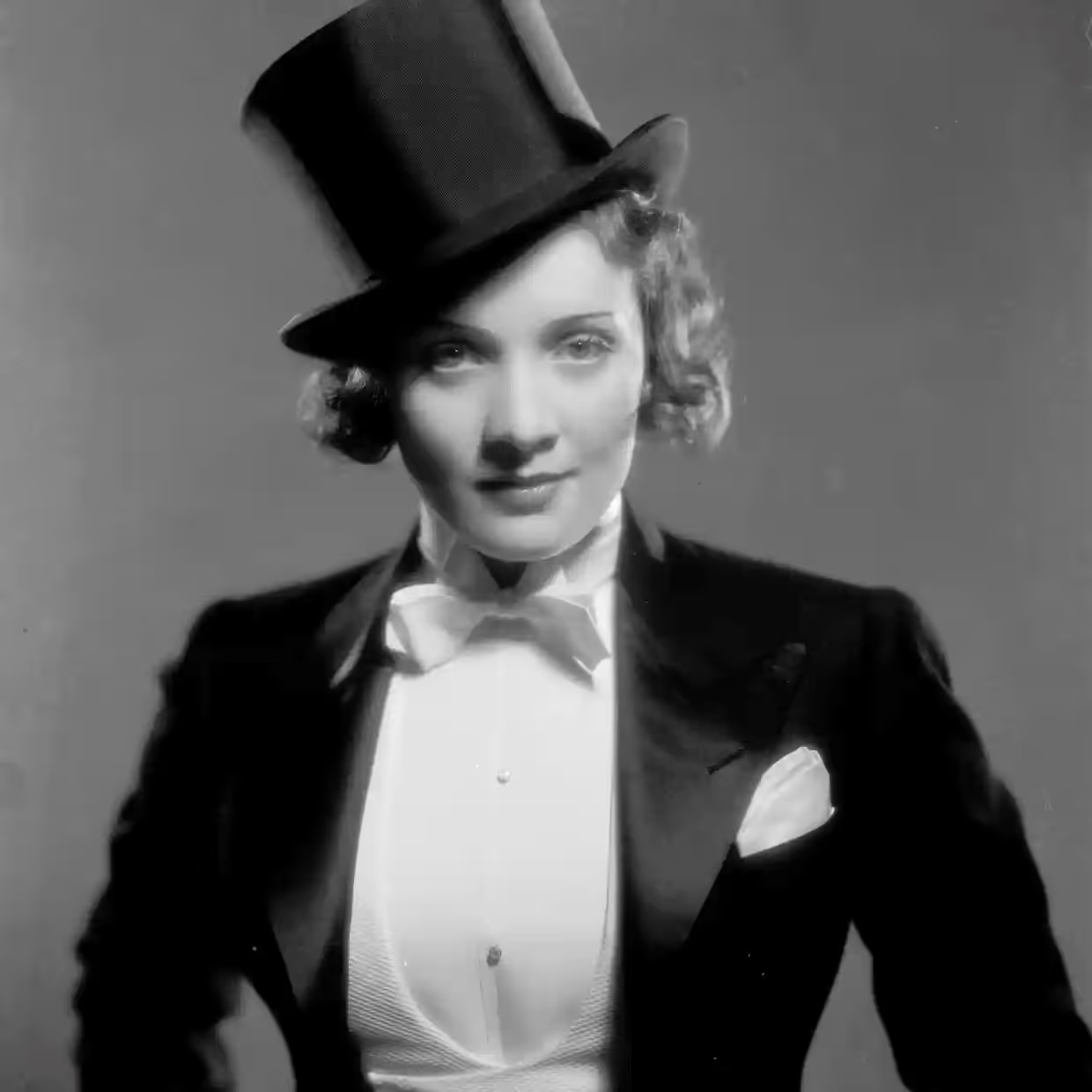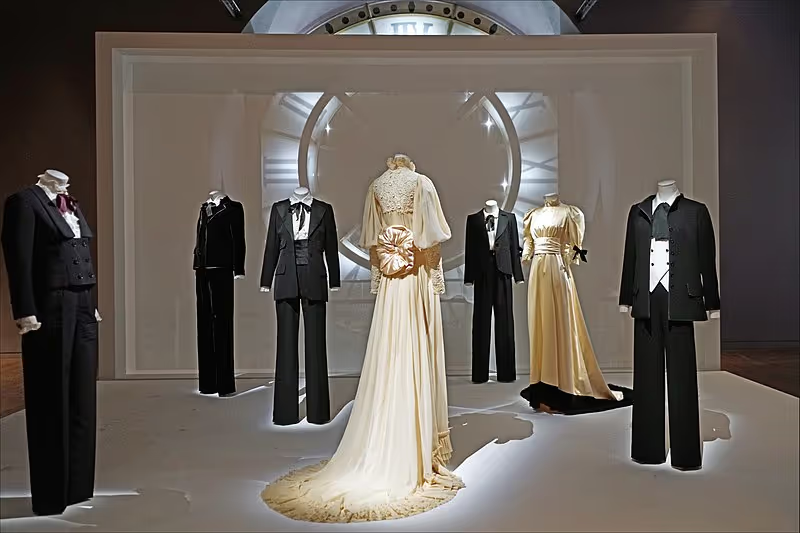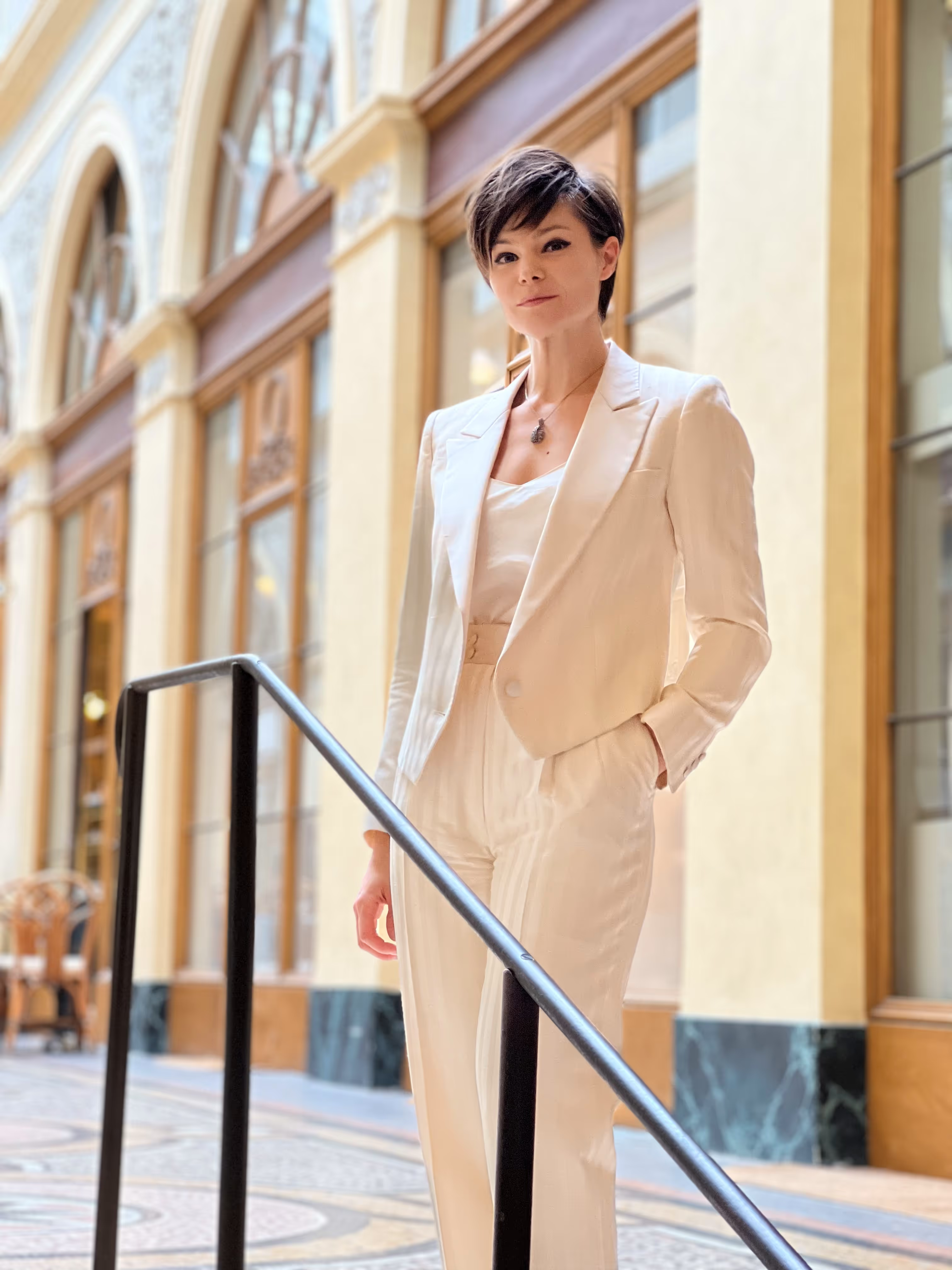Parisian Gentleman - © 2009-2020 - Mentions légales - Réalisé par HVLD digital

We can say tuxedos (semi-formal black tie) and tailcoats (formal white tie) are two reference pieces in a sartorial wardrobe which conform to a specific social context. Whether worn as compulsory or as a passionate expression, the tuxedo undeniably takes part in the collective imagery of intimacy and publicity — as an art of sartorialism, as well as partying ! I didn’t know the feminine variations of black and white tie attire, and had long-imagined women wearing tuxedos as being more “haute couture” than functional.
A friend I was chatting with, while discussing the feminine adaptation of the masculine wardrobe, told me this exquisite sentence : “Whatever, you women stole all of our clothes : suits, waistcoats, everything ! And even tuxedos!”
Nothing is more appealing than that ; and I engaged in research, to see what this was all about. I realized that black tie, along with white tie, compose a feminine side of sartorial history that I would qualify as one of the most compelling.
The history of the feminine tuxedo begins during the Roaring Twenties. The “tomboy” style is, at the moment, popular, and of the most perfect Parisian elegance, in the world of the nightlife and of cabarets. Some leading feminine figures make the tuxedo an audacious symbol of feminist advocacy. Marlene Dietrich is one of them ; the famous actress, along with some other colleagues and friends, make the tuxedo an essential component of the wardrobe of the regular feminine clientele of the cabaret “Le Monocle”, an establishment of very nefarious reputation.

Dietrich appears in the movie entitled Morocco, by Joseph Von Sternberg (1930), dressed in elegant black tie. In this film, she embodies Amy Jolly, a music-hall performer, as well as a liberated and fascinating woman.


During the following decades, the industry of cinema makes the tuxedo an iconographic element which characterizes music-halls and musicals. The actress Eleanor Powell achieves an incredible tap dancing performance in the movie Broadway Melody of 1938, dressed in white tie. She renews the mood in the movie Lady Be Good (1941) by Norman Z. McLeod, in the number “Fascinating rhythm”, during which the actress wears a reinvented version of the main elements of the white tie which include large lapels of satin and pleated belt.

In entertainment, we observe women, actresses, performers or singers dressed with the same black tie or white tie as their masculine colleagues albeit with a more fitted jacket ; hence, setting an echo or on the contrary, a contrast. Other actresses propose a more glamorous version of the classic outfit, as Judy Garland shows us in the musical A Star Is Born, by George Cukor (1954). Garland adds a twist to the tuxedo jacket by matching it with an audacious split skirt.

I’m led to the question : what is the obsession with formality and musicals ? White tie and black tie play a pivotal part in such movies, whose musical genre highlights significant feminine figures.
Beyond the aesthetic choices, 1940s and 1950s are sites of sartorial claims, feminine as well as feminist. Though of subtle effect, such sartorial statements by women are nevertheless significant. The actress Katharine Hepburn fights throughout her entire life to make her “masculine” elegant style accepted. “Each time a man tells me he prefers a woman wearing a skirt, I ask him to try it. To try to wear one” she declared to the famous designer Calvin Klein. When the journalist Barbara Walters asks her, in 1981, if she owns at least one dress, she cannot hide her annoyance, along with her delightful irony : “Yes, Mrs Walters. I own a dress, the one I will wear when I will attend your funeral”. One of Hepburn’s most beautiful tuxedos is none other than the one she wears in the movie Woman of the Year (1942) by George Stevens donning a perfectly tailored jacket, but dropping the bow tie.


The Roaring Twenties’ liberalization of style, and the enshrinement of various feminine approaches to white tie and black tie during Hollywood’s Golden Age remains exceptional.
Women’s everyday style is often limited by a form of conservatism, and such outfits as described above can be perceived as prohibited, even in the most elegant and wealthy high-society. During the 1950s and the 1960s, women could only wear suits once in a while ; at the time, some restaurants or hotels refused entry to women wearing trousers. This discussion is not only about fashion or silhouette : one’s outfit becomes a claim. High fashion houses play with controversy as elements of counter-culture or as a political or social manifesto.
Yves Saint Laurent, during his Autumn-Winter 1966 runway show, launches his assault by presenting his design of a feminine tuxedo. He displays “straight trousers, a white organza shirt with a ruffled collar [replacing the classic masculine collar], a lavallière, a satin belt, and a long jacket “feminized” by a tight fitting"(1). The jacket also features three buttoned pockets, and a silk ribbon replaces the classical bow tie.

This exceptional piece of fashion is now referred to as Le Smoking, with capital letters. And Saint Laurent relapses into boldness on the occasion of his Spring-Summer 1967 show, where he presents his tuxedo short dress, along with several feminine trouser suits, and with La Saharienne - do not forget the capital letters ! Saint Laurent is recognized by the Women’s Wear Daily magazine as the “most elegant bomb thrower in the world of fashion”(2), and his masterpiece makes itself known during the following years. The funny thing about this story is that the outfit initially becomes successful ready-to-wear model, before reaching its apogee as a couture masterpiece.
A feminine tuxedo ? Nefarious, scandalous, but undoubtedly seductive. Nan Kemper, whom Saint Laurent referred to as the “most chic woman in the world”(3) is refused entry, a few months later, to the restaurant La Côte Basque, in New York. She arrives there dressed in a tuxedo, just like her masculine colleagues. Without thinking twice, she takes off her trousers, and ties her jacket as a skirt, before entering the restaurant. An arranged tux is still a tux, and wearing it becomes, during the following years, the symbol for feminine emancipation, while women begin to gain access to social, political as well as economic positions similar to those of men. This does not prevent the singer Françoise Hardy from being “booed” when she arrives at the Opera, right before creating a sensation when wearing this suit for the Thanksgiving parade at Macy’s.

The tuxedo is also one of the elements of the feminine wardrobe allowing one to draw a distinction between style and fashion. This very distinction, well-known by the aficionados of the sartorial universe, sometimes experiences difficulties emerging into a feminine marketplace which is often saturated. The tuxedo is timeless, making its use an act of style, and not of fashion. “Fashion is what becomes old-fashioned”, Jean Cocteau said. Several feminine figures make the tuxedo a demonstration of elegance, such as Lauren Bacall, Liza Minelli, Bianca Jagger, or Catherine Deneuve. “What characterizes the tuxedo is the way it is both masculine and feminine. It really makes you feel different, as a woman, and changes your attitude”, the latter declared.
The tuxedo is now installed in the history of feminine fashion, and offers a privileged spot from which its relations to the social and aesthetic history can clearly be noticed. In 1975, the famous photographer Helmut Newton composes a series of portraits where Saint Laurent’s masterpiece is worn by androgynous models, reminding us of the flappers’ scandal in the Twenties.
In the sartorial universe, the black tie is limited to opera, or the parties requesting it. It is difficult to get an overall picture of the commercial offer aimed at women, but there is no doubt it is limited, except in bespoke. The feminine tuxedo is undoubtedly noticed and remembered when worn - and I would like to add that it could even be admired more!

So, as a matter of fact, the feminine black tie or white tie is picked up from the masculine wardrobe… But I must confess, at the end of this little paper, that I think it is definitely for the best !
(1) Description of The Smoking, catalogue of the exhibition Yves Saint Laurent, by Farid Chenoune, Florence Müller, Jéromine Savignon et Bernard Blistène, exhibition by the Petit Palais-Musée des Beaux-Arts de la ville de Paris, 11 mars - 29 août 2010, Paris, éditions La Martinière, p. 142
(2) Séverine de Smet, in her article “31 juillet 1966, le jour où… Saint Laurent présenta Le Smoking”, in Le Nouvel Observateur, n°2594, Juillet 2014, p. 79-81
(3) Yves Saint Laurent quoted in an article by Justine Picardie, “New York Doll”, in The Daily Telegraph, 10 décembre 2006
Cover picture : Laetitia Hedde wearing a vintage Smalto tuxedo